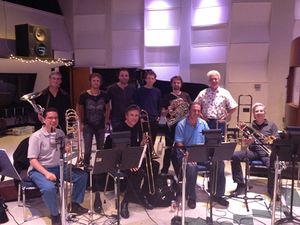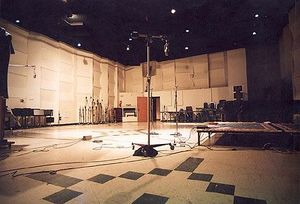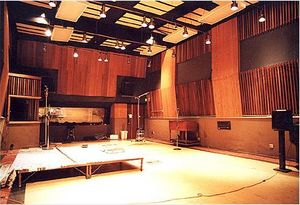EastWest Studios
EastWest Studios, are a music studio facility, based in Los Angeles, California, USA. EastWest was originally known as Western Studio, which was a component of United Western Recorders, before being renamed to Ocean Way Recording. In the 1990s, the studio split and was renamed to Cello Studios, which later became EastWest Studios.
History
In the 1960s, Bill Putnam had founded the prestigious Universal Recording studio in Chicago. A pioneer of modern recording technique, Putnam became well known for his UREI recording equipment and custom-made Universal Audio mixing consoles, which were bought by major recording studios. After relocating to Hollywood in 1957, and with the backing of Bing Crosby and Frank Sinatra, Putnam first established the United Recording Corp. studio complex at 6050 Sunset Boulevard in Hollywood. In 1961, he purchased the neighboring Western Studio at 6000 Sunset, remodeling and incorporating the building into the complex. The buildings were then renamed United Western Recorders, and catered to some of the biggest artist of the era including Frank Sinatra, The Beach Boys and Elvis Presley.
United Western Recorders was sold in 1984, and was renamed to Ocean Way Recording, still operating as two split studios. 14 years later, in 1998, the Western Studio half was divided from Ocean Way Recording. The studio was sold and became known as Cello Studios. The studio ceased operation in 2005. The facility itself was bought by Doug Rogers in 2006, who commissioned engineer and designer Philippe Starck to redesign and rebuild it into what is now EastWest Studios. Lounges, reception areas and kitchen were all refurbished, while the original recording facilities were preserved as much as possible. EastWest Studios opened in 2009 and have been operational ever since.
Studios
Studio One
Studio One features an 80-channel Neve 8078 console with 32-channel monitor section, the largest such console in the world, which was originally commissioned for Michael Jackson's best-selling album, Thriller. The control room is equipped with Meitners (available upon request) and ATC300A house monitors, with NS10/ProAc speakers, set up with the Pro Tools Ultimate system. Studer 827 & Ampex ATR102 analog recorders in 1/4 inch & 1/2 inch are available on request. The studio comes with an isolation booth and a Bechstein D-280 grand piano.
Frank Sinatra recorded such hits here as “My Way”, “That’s Life”, & “New York, New York”, while Elvis Presley revived his career with his 1968 Comeback Special and Barbara Streisand recorded her smash “The Way We Were”. Since then, a list of music royalty have left their mark here. This includes sessions for movie soundtrack including Mission Impossible, M.A.S.H. and The Godfather.
Studio One is the studio in which Muse recorded orchestral sections for The 2nd Law, on songs like Supremacy, Unsustainable and Isolated System.
Studio Two
Studio Two offers a Neve RCA Custom 8028 Console with 40 channels, one of only two built with Class A discrete electronics. Like Studio One, the control room of Studio Two is equipped with Meitners (available upon request) and ATC300A house monitors, with NS10/ProAc speakers, and is set up with Pro Tools Ultimate. Studer 827 & Ampex ATR102 analog recorders are available on request. The studio also has additional drum and vocal iso booths, and it also includes a Yamaha C7 grand piano.
Originally, Studio Two was the site where the themes from many classic television shows were recorded (The Monkees, The Partridge Family, The Beverly Hillbillies, Hawaii Five-0). The studio later evolved to serve the needs of rock bands like Red Hot Chili Peppers, Green Day, Weezer, Metallica and others.
Studio Two is where Muse recorded the brass section for Panic Station, and where Animals and Madness were (partially) recorded.
Studio Three
The studio comes with a 40-channel Trident A Range console, complete with the Neve Flying Faders automation. It is the original A range console and one of six surviving in the world. Like Studios One and Two, the control room is equipped with Meitners, available upon request, and ATC300A house monitors, with NS10/ProAc speakers, and is set up with Pro Tools Ultimate. Both the previously mentioned Studer and Ampex recorders are available upon request.
Studio Three is perhaps the most famous of the studios in the complex, with its design being copied by recording studios across the globe. The studio is the birthplace for some of the most iconic hits of the 1960s, including The Mamas and The Papas' "California Dreaming", Scott McKenzie' "San Francisco" and The Beach Boys' "Pet Sounds".
Studio Five
A mix room, Studio Five features a 64-channel SSL 4064 G+ console with Ultimation and VU Metering, and features a customized center section that houses a 26" Apple Cinema Display, Custom Augsperger 2x15 monitor mains, and 18" JBL subwoofers, all driven by Bryston amps. It is run on a Pro Tools HDX system. NS10s, ATC 25 and Pro Ac monitors are also available, as are the Studer and Ampex recorders. The studio underwent through extensive renovation in 2013 and is now the most modern of the studios, opening in 2014.
Studio Five was the studio at which songs by artists like R.E.M., Franz Ferdinand and Nirvana were mixed, aswell as motion picture soundtracks like those of Spider-Man, Daredevil and Trolls. Studio Five is also where Absolution was mixed.
Albums recorded by Muse here
- The 2nd Law (partially)


